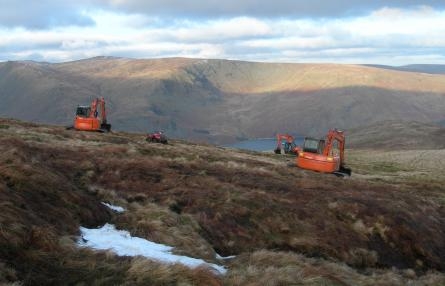Two successful bids in the north will fund peatland conservation from the Peak District to the Scottish border. The vast project area spans almost 4,200 hectares; the same size as more than 6,700 football pitches.
Northern greenhouse
A panel of experts and Defra officials assessed the projects and awarded the funding based on the value to wildlife and the potential for carbon capture. The fundamental work will contribute to the UK’s climate change goals by helping the peatland landscape to lock in carbon, instead of releasing it into the atmosphere.
Defra has allocated a total of £10 million between four peat restoration projects in England, including over £7.4 million to two in the north:
The North of England Peat Partnership, led by the Yorkshire Wildlife Trust, will restore 394 hectares of lowland raised bog and 1,679 hectares of blanket bog across 21 peatland sites.
Cumbria Wildlife Trust is one of the partner organisations involved and is working on behalf of the Cumbria Peat Partnership. The local wildlife charity will be working with landowners of five large areas in the Cumbrian fells over the next three years, in both the Lake District and Yorkshire Dales National Parks. The grant will employ people to help turf grow back over eroded areas of ground, and to block drains through wetlands to prevent further erosion of delicate peatland habitats, some of which are currently releasing sediment into rivers and reservoirs.
Peat cutting for domestic fuel was once widespread across much of the country, leaving our bogs in a vulnerable state, prone to damage by people and livestock ever since. Cumbria is fortunate to still support many rare and unusual peat bog species, including the tiny bog orchid, various carnivorous plants, white-faced darter dragonflies and upland birds such as the golden plover, dunlin and short-eared owl.
Simon Thomas, Cumbria Wildlife Trust’s Peatland Restoration Officer, said: “We are delighted that this government support will allow us to continue the great work that many local farmers have already undertaken with our help. Our aim is to recreate the conditions that will allow peat to form once more, so that the fells can sustain themselves in the face of further climate change, which is expected to increase the risk of peat erosion.”
Funding has also been awarded to the RSPB and North Pennines AONB for work on a further two sites in Cumbria, one on the Solway and another in the North Pennines.
Dr Tim Thom, Peat Programme Manager at Yorkshire Wildlife Trust, said: “It’s fantastic to see peatlands on the Government’s agenda and getting the recognition they deserve – both in terms of the benefits they bring and the parlous condition we have let so many of them reach.
“This funding will enable us to restore some of the most important and beautiful sites across the north – from England’s largest lowland raised bog in South Yorkshire all the way up to Northumberland’s highest point near the Scottish border.”
Moors for the Future Partnership will deliver conservation work on seven sites, in the Moor Carbon project, covering more than 2,100 hectares of blanket bog peatlands. The Partnership hopes to venture into new territory; into the newly-designated West Pennine Moors Site of Special Scientific Interest (SSSI), as well as across the Peak District National Park and South Pennines. It will invite stakeholders in moorland areas stretching from Buxton in the Peak District National Park, to near Burnley in Lancashire, to become part of this project.
Chris Dean, Head of Programme Delivery at Moors for the Future Partnership commented: “Our peatlands are wild places that mean so much to so many people. We will use these strong emotions and attachments as a guide to carrying out this conservation work. We look forward to working together in partnership with other organisations across the north of England, to ensure that generations to come can benefit from and enjoy our amazing blanket bogs.”
Carbon capture
The work will ensure that more than 14,700 tonnes of carbon per year is locked down into the blanket bog moors; the same amount of carbon as an average car driving non-stop for over 65 years!
Peatlands across northern England have been badly degraded by decades of industrial pollution and wildfires. Acid rain and wildfire has killed off vital bog-mosses, called Sphagnum, leaving the peat beneath bare and exposed.
On healthy peatlands, special plants help the peat to suck in carbon out of the air, like trees do. But when the peat is bare, carbon is released into the atmosphere. The conservation work taking place will help to make a big difference to the UK’s target to reduce carbon emissions by at least 80% of its 1990 levels by 2050.

